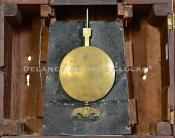This extraordinary wood-front timepiece is attributed to Joseph Nye Dunning, one of Vermont’s most prolific clockmakers. This clock was made in Burlington, Vermont, circa 1833. 223080.
This timepiece features a unique design. The case is constructed in mahogany and has been recently refinished. The throat panel features a very unusual design in that the bowed-shaped carved wooden side arms serve double duty. They are decoratively formed and provide the structure that supports the wooden panel. This is an interesting departure from the typical brass versions usually found in this location. Their creation demonstrates the cabinetmaker’s willingness to experiment and try something different. Veneered ribbon mahogany wooden panels are featured in the wooden frames. The grain pattern is striking. The choice of wood selections and cursive side-arm design make this a rare and stunning timepiece. A wood-turned acorn finial surmounts the cast brass bezel that opens to access the dial.
The painted metal dial is formatted with Roman-style hour numerals. Open moon-style steel hands display the time.
Behind the dial is a brass, weight-driven movement. It is designed to run for eight days once fully wound. Two screws through the back plate secure it to the case. The teeth in the gear train are deeply cut. The pendulum is suspended in front of the works by a butterfly-shaped bridge. The metal rod is fitted with a Concord-style keystone and a brass-faced bob. A butterfly-shaped tie-down is mounted to the weight tin. Joseph Dunning is known to have used the “butterfly” form when building these components. The bridge and tie-down strongly suggest Dunning as the creator of this clock.
This mahogany case is 33.5 inches long, 10 inches wide, and 3.5 inches deep.
Inventory number 223080.








